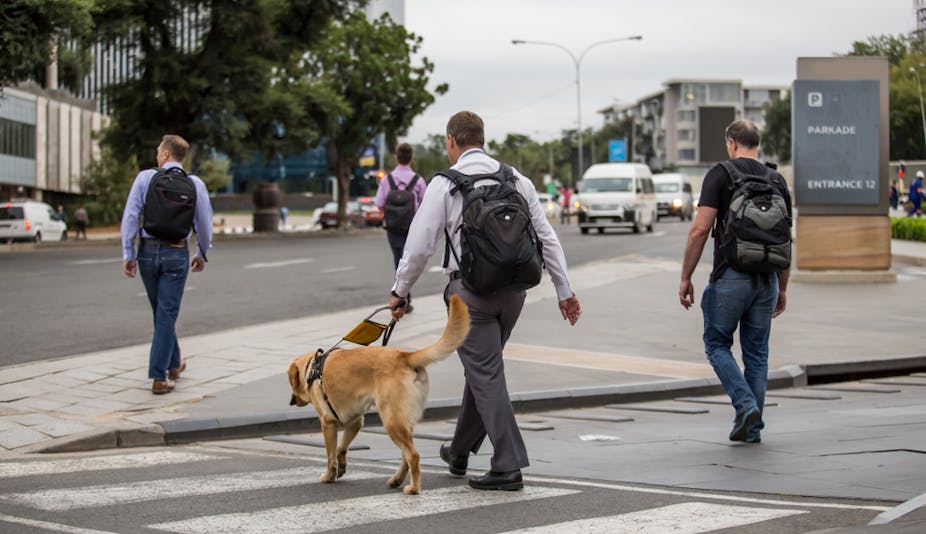South African census data from 2011 estimate a disabled population of 7.5%. The census approaches disability as levels of difficulty in six areas – seeing, hearing, communicating, remembering or concentrating, walking and self-care. According to this data, about 1.7% of South Africans experience severe visual difficulty.
The definition of legal blindness includes an array of conditions and levels of visual difficulty. Essentially, a blind person will not be able to see at 3 metres what a sighted person could see at 60 metres.
South Africa has 22 special schools for the blind, but a 2015 report revealed that they are short of resources and the standard of education offered to visually impaired learners is low. As a result, entrance into tertiary education is low.
It is estimated that 97% of visually impaired South Africans are unemployed.
Another challenge is the cultural beliefs that people encounter. These beliefs connect blindness to ideas about fear, ignorance, incapability and dependence. Negative ideas influence the way that society interacts with blind people.
This may be the experience of people who lose their sight gradually. The majority of visual impairment in South Africa results from preventable or treatable conditions. These include glaucoma and cataracts, which cause gradual vision loss if not correctly treated.
When people begin to lose their sight they might well lose their job and be isolated from other people.
Rehabilitation services play an important role, providing essential skills for adjusting to life with visual impairment. These skills include white cane mobility training, coping with daily living (such as cooking and household management), computer literacy with assistive software and Braille literacy. Rehabilitation services may also include courses in life skills, office administration and work readiness.
This practical training is certainly important. But my PhD research found that rehabilitation services for visually impaired adults need to focus more on identity and building a positive sense of self and belonging. People who experience sight loss are likely to have been exposed to negative ideas about the status and capabilities of blind people, and they may have experienced discrimination and exclusion. They have to deal with not only the practical implications of vision loss but a sense of what it might mean for their future.
Better rehabilitation
I conducted in-depth interviews with people who used and offered rehabilitation services. The users were adults who had experienced vision loss later in life. The service providers included occupational therapists, social workers and training facilitators.
I found that rehabilitation services that focus on the practical challenges of visual impairment do not adequately support individuals who may be experiencing significant trauma. Service users’ accounts also suggested that undergoing rehabilitation could further destabilise their sense of self and belonging. One participant said:
The way they treated adults was really taking something from them.
Others expressed their feelings about the type of support they needed:
You need to not just learn how to cook and learn how to read Braille and learn how to walk with a cane, you need to be given the tools to live a well-rounded, mentally well life.
I’ve just been on a mission of trying to find a way for me to sustain myself and also for me to move forward and to develop.
The way in which rehabilitation services are approached may unintentionally strengthen a negative view of blind people. Service user accounts describe an imbalance of power in rehabilitation organisations, where they felt as though they were not able to exercise choice. They often felt they were not valued as stakeholders in rehabilitation and that they were not able to choose how to move forward in their lives.
In South Africa, rehabilitation services operate as charities funded in part by government but relying increasingly on donations from the corporate sector and the public. This can also be damaging to service users’ sense of self as they become viewed as recipients of goodwill rather than as active participants in a process of skills development.
Sense of empowerment
To make rehabilitation more holistic, it is important to consider what is being imparted to visually impaired people about who they are. These ideas will be carried forward into their lives. To be empowered citizens, they need more than special skills and assistive devices. They need a positive sense of themselves as valuable, whole people who are able to contribute and participate in their families and communities.
To address the identified gaps in rehabilitation services for visually impaired adults, the training of rehabilitation workers must include greater emphasis on the internal negotiations of self and place.
In addition, rehabilitation service users must be viewed as central stakeholders in their own processes of rehabilitation, and empowered to make their own decisions.

